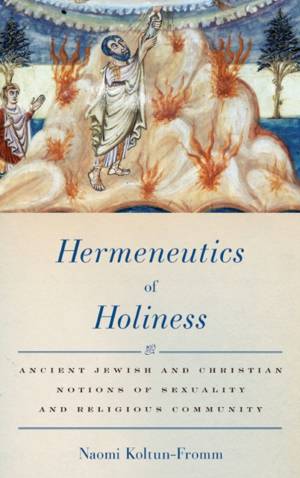
Door een staking bij bpost kan je online bestelling op dit moment iets langer onderweg zijn dan voorzien. Dringend iets nodig? Onze winkels ontvangen jou met open armen!
- Afhalen na 1 uur in een winkel met voorraad
- Gratis thuislevering in België vanaf € 30
- Ruim aanbod met 7 miljoen producten
Door een staking bij bpost kan je online bestelling op dit moment iets langer onderweg zijn dan voorzien. Dringend iets nodig? Onze winkels ontvangen jou met open armen!
- Afhalen na 1 uur in een winkel met voorraad
- Gratis thuislevering in België vanaf € 30
- Ruim aanbod met 7 miljoen producten
Zoeken
Hermeneutics of Holiness
Ancient Jewish and Christian Notions of Sexuality and Religious Community
Naomi Koltun-Fromm
Hardcover | Engels
€ 160,45
+ 320 punten
Omschrijving
In Hermeneutics of Holiness, Naomi Koltun-Fromm examines the ancient nexus of holiness and sexuality and explores its roots in the biblical texts as well as its manifestations throughout ancient and late-ancient Judaism and early Syriac Christianity. In the process, she tells the story of how the biblical notions of "holy person" and "holy community" came to be defined by the sexual and marriage practices of various interpretive communities in late antiquity. Koltun-Fromm seeks to explain why sexuality, especially sexual restraint, became a primary demarcation of sacred community boundaries among Jews and Christians in fourth-century Persian-Mesopotamia. She charts three primary manifestations of holiness: holiness ascribed, holiness achieved, and holiness acquired through ritual purity. Hermeneutics of Holiness traces the development of these three concepts, from their origin in the biblical texts to the Second Temple literature (both Jewish and Christian) to the Syriac Christian and rabbinic literature of the fourth century. In so doing, this book establishes the importance of biblical interpretation for late ancient Jewish and Christian practices, the centrality of holiness as a category for self-definition, and the relationship of fourth-century asceticism to biblical texts and interpretive history.
Specificaties
Betrokkenen
- Auteur(s):
- Uitgeverij:
Inhoud
- Aantal bladzijden:
- 328
- Taal:
- Engels
Eigenschappen
- Productcode (EAN):
- 9780199736485
- Verschijningsdatum:
- 24/09/2010
- Uitvoering:
- Hardcover
- Formaat:
- Genaaid
- Afmetingen:
- 241 mm x 165 mm
- Gewicht:
- 609 g

Alleen bij Standaard Boekhandel
+ 320 punten op je klantenkaart van Standaard Boekhandel
Beoordelingen
We publiceren alleen reviews die voldoen aan de voorwaarden voor reviews. Bekijk onze voorwaarden voor reviews.











